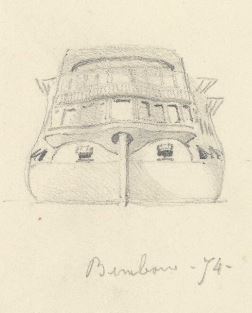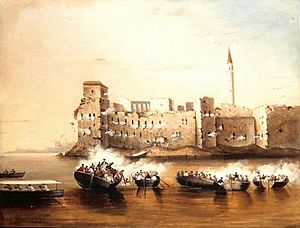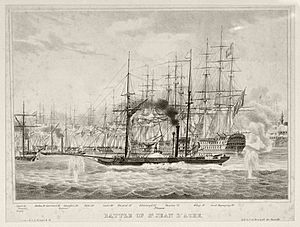HMS Benbow (1813) facts for kids

Study of HMS 'Benbow in Portsmouth Harbour, 1826
|
|
Quick facts for kids History |
|
|---|---|
| Name | HMS Benbow |
| Ordered | 11 June 1808 |
| Builder | Brent, Rotherhithe |
| Laid down | July 1808 |
| Launched | 3 February 1813 |
| Fate | Broken up, 1895 |
| Notes | Coal hulk from August 1859 |
| General characteristics | |
| Class and type | Vengeur-class ship of the line |
| Tons burthen | 1773 bm |
| Length | 176 ft (54 m) (gundeck) |
| Beam | 47 ft 6 in (14.48 m) |
| Depth of hold | 21 ft (6.4 m) |
| Propulsion | Sails |
| Sail plan | Full-rigged ship |
| Armament |
|
HMS Benbow was a large sailing warship of the Royal Navy, the navy of the United Kingdom. It was built by a company called Brent in Rotherhithe, England. The ship was launched on February 3, 1813.
Benbow was a "74-gun third-rate ship of the line." This means it was a powerful warship that carried 74 cannons. These ships were designed to fight in a line formation during naval battles.
HMS Benbow was part of the Vengeur-class ships of the line. These were a group of similar warships built for the Royal Navy. Benbow was a full-rigged ship, meaning it had three masts with square sails. It relied completely on wind power to move across the oceans.
Action in the Mediterranean
In 1840, HMS Benbow was involved in a conflict known as the Egyptian-Ottoman War. It took part in the bombardment of the city of Acre. This city, located on the coast, was heavily defended.

During the battle, Benbow was under the command of Admiral Robert Stopford. At a key moment, either Benbow or another ship, HMS Gorgon, fired a shell that hit Acre's main powder magazine. A powder magazine is a place where gunpowder and ammunition are stored.
The explosion of the powder magazine was huge. It greatly weakened the city's defenses and helped the Royal Navy win the battle.
Later Life and Retirement
After its time in battle, HMS Benbow had a quieter life. From February 1848, it was used for "harbour service." This means it stayed in port and helped with various tasks around the harbour.
In August 1859, Benbow was changed into a "coal hulk." A coal hulk was an old ship used to store coal. Coal was very important for powering steamships at the time. So, Benbow became a floating storage facility.
After 79 years of service to the Royal Navy, HMS Benbow was finally sold in 1892. It was then "broken up" in 1895 at a place called Castle, in Woolwich. To be "broken up" means the ship was taken apart, and its materials were recycled or discarded.


